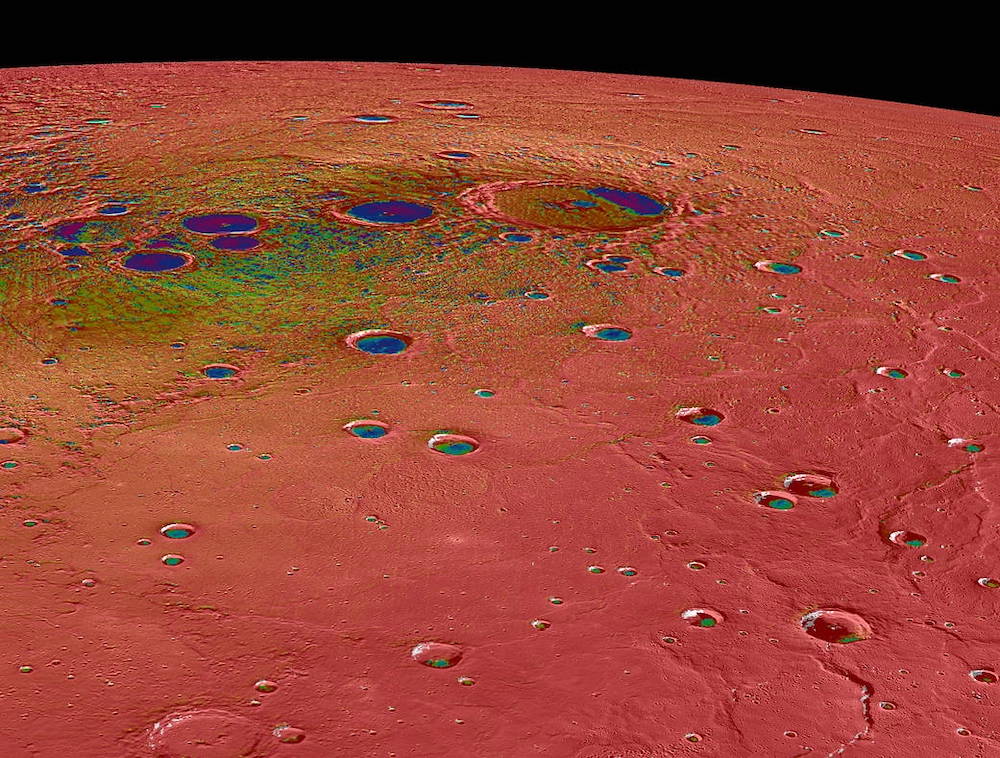Create a free profile to get unlimited access to exclusive videos, sweepstakes, and more!
Isn’t it ironic that Mercury, the planet closest to the Sun, has ice on its poles?
This planet knows how to chill.

Mercury has closer encounters with the Sun than any other planet in the solar system. It seems that such a planet would be doomed to turn into another Arrakis, especially after billions of years of being scorched by radiation.
You would think that this planet literally has no chill because of its proximity to the fires of our star. While ice on Mercury sounds like an oxymoron, it actually exists. Astronomers caught on to the suspicion that its poles could be icy from radar observations in the early ‘90s, and now that the technology has leveled up, Mercury is revealing its cold shoulder. Now astronomer Edgard River-Valentín of the Lunar and Planetary Institute in Texas, who led a study recently published in The Planetary Science Journal, has observed them more closely than ever.
“We used Arecibo radar observations of the region and compared crater floors to background terrain,” he told SYFY WIRE. “Given hi-res topography data from MESSENGER, we were able to back-model what material would need to be in the floor of the craters to cause what we were seeing.”
When you’re the planet closest to the Sun, it would seem like the last thing you would be able to hold onto is ice, but that thought can be deceptive. The Sun ruthlessly blasts the Moon with radiation every day, but that is still unable to reach permanently shadowed regions (which is why future astronauts might take an interest in them). Same with Mercury. These regions are like built-in refrigerators with low floors, far down enough for water ice to remain stable, and walls that cast huge shadows and shut out radiation which would otherwise melt or vaporize the ice. Sunlight will never reach the floor of these formations.
The shade of these shadow realms and Mercury’s tilt both make sure that they will stay cold indefinitely. If the ice is buried in regolith, that also keeps it from being exposed to the Sun, and it is thought that some craters are shielded by regolith. So how can deposits of ice be detected if they are hiding in the dark? This is where the now-defunct Arecibo radio telescope comes in. Radar light that hits a surface will scatter and be reflected back to the observer. Ice has a high albedo, meaning it reflects a high amount of light, though there isn’t always ice in radar bright features.
“The important thing to note about radar bright regions is how radar scatters and reflects back at us depends a lot on the angle that the transmitted light hits the surface at,” River-Valentín said. “when we shine radar light on planets the incoming angle depends on the latitude.”
Say that radar telescopes were stars beaming light. These “stars” would be lower on the horizon (if you had radio vision and were seeing them from Mercury) at higher latitudes. At these high latitudes, meaning Mercury’s poles, ice is the only thing scattering back so much radar light, and only something with an albedo as high as that of ice could do that at such angles. Rocks and other obstacles at lower latitudes could bounce much of that light back. Finding out how pure the ice is depends on how much radar light it scatters at the telescope.
“The less pure ice is, the less it will scatter radar light back to the telescope,” River-Valentín said. “So we studied the variation in radar brightness across the deposits to get at new estimates as to how pure the ice there may be.”
This could be useful for creating radar maps of the Moon, especially since water ice is something that astronauts will need to be near if they are going to stay awhile. Besides drinkable water, it can also provide breathable air and even rocket fuel. The same can be done for Mars. Frozen regions on other planets can also be explored for ice that might indicate the chance of habitability. There are extremophiles that live in ice on Earth, and even if nothing is alive in alien ice, its presence could still mean there might have been liquid water around in the distant past.
Though River-Valentín and his research team had to change the method they thought they were going to use on the Moon, because ice was indistinguishable from the background with that method, they now plan to use upgraded radar detection. Maybe their new way of seeking out lunar ice could make NASA less apprehensive about sending off a manned Artemis mission (whenever that is).
By the way, one of these icy patches on Mercury is called Tolkien. Still, there needs to be one named for Frank Herbert on this hot, dry, Dune-esque planet.


























